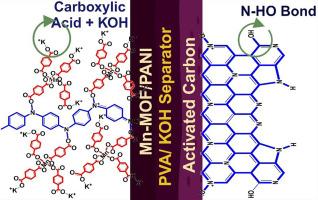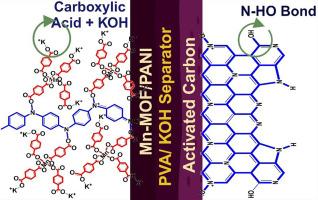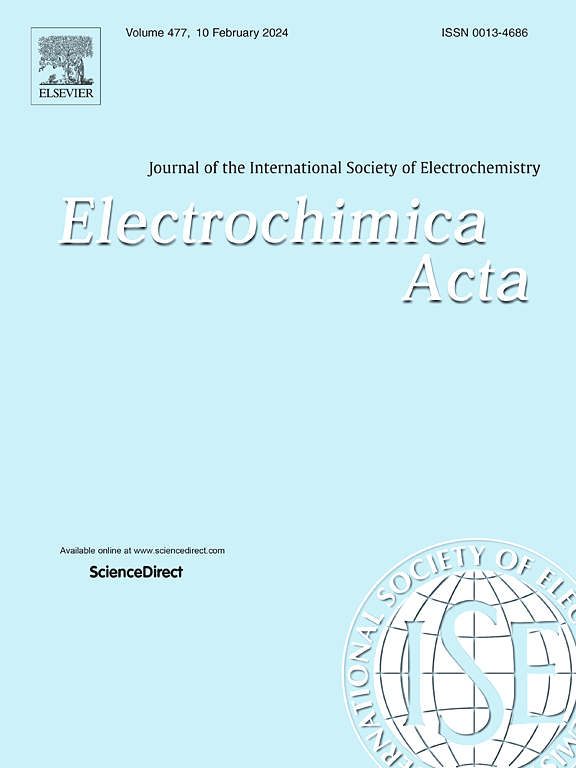Exalted charge transfer mechanism through effective interfacial engineering of Mn-BDC MOF and PANI for hybrid capacitor
IF 5.6
3区 材料科学
Q1 ELECTROCHEMISTRY
引用次数: 0
Abstract
Mn-1,4 benzene dicarboxylic acid (BDC) MOF/Polyaniline (Mn-BDC MOF/PANI) composites have emerged as promising materials for hybrid capacitors due to their synergistic properties. In this work, we present a DFT-assisted design approach to enhance the hybrid capacity of the composites. We synthesized Mn-BDC MOF and PANI using solvothermal and chemical polymerization techniques, respectively, and then composited them using the sonochemical method. The Mn-BDC MOF/PANI composite exhibited a unique morphology with Mn-BDC MOF rods intertwined within the PANI matrix. Electrochemical characterization revealed superior energy storage performance of the Mn-BDC MOF/PANI composite, particularly in the negative potential window. Importantly, the composite-loaded graphite sheet electrode displayed a specific capacity of 356 mAh g-1 at 1 A g-1 and excellent cycling stability with 96.6 % capacity retention after 10,000 cycles. Density functional theory (DFT) calculations further elucidated the detailed charge transfer mechanism at the Mn-BDC MOF/PANI interface, highlighting the enhanced electronic states near the Fermi level in the composite, contributing to its improved capacity. The Mn-BDC MOF/PANI||AC asymmetric hybrid capacitor delivered an energy density of 359.4 Wh kg-1 and a power density of 1556 W kg-1, demonstrating its potential for practical energy storage applications.


基于Mn-BDC MOF和聚苯胺有效界面工程的混合电容器高电荷传递机制
mn -1,4苯二甲酸(BDC) MOF/聚苯胺(Mn-BDC MOF/PANI)复合材料由于其协同性能而成为一种很有前途的杂化电容器材料。在这项工作中,我们提出了一种dft辅助设计方法来提高复合材料的混合能力。采用溶剂热法和化学聚合法分别合成了Mn-BDC MOF和聚苯胺,并采用声化学方法进行了合成。Mn-BDC MOF/PANI复合材料表现出独特的形貌,Mn-BDC MOF棒在PANI基体中缠绕。电化学表征表明Mn-BDC MOF/PANI复合材料具有优异的储能性能,特别是在负电位窗口。重要的是,复合材料负载的石墨片电极在1 a g-1时的比容量为356 mAh g-1,并且具有出色的循环稳定性,在10,000次循环后容量保持率为96.6%。密度泛函理论(DFT)计算进一步阐明了Mn-BDC MOF/PANI界面上详细的电荷转移机制,突出了复合材料在费米能级附近的电子态增强,有助于提高其容量。Mn-BDC MOF/PANI||交流非对称混合电容器的能量密度为359.4 Wh kg-1,功率密度为1556 W kg-1,显示了其在实际储能应用中的潜力。
本文章由计算机程序翻译,如有差异,请以英文原文为准。
求助全文
约1分钟内获得全文
求助全文
来源期刊

Electrochimica Acta
工程技术-电化学
CiteScore
11.30
自引率
6.10%
发文量
1634
审稿时长
41 days
期刊介绍:
Electrochimica Acta is an international journal. It is intended for the publication of both original work and reviews in the field of electrochemistry. Electrochemistry should be interpreted to mean any of the research fields covered by the Divisions of the International Society of Electrochemistry listed below, as well as emerging scientific domains covered by ISE New Topics Committee.
 求助内容:
求助内容: 应助结果提醒方式:
应助结果提醒方式:


